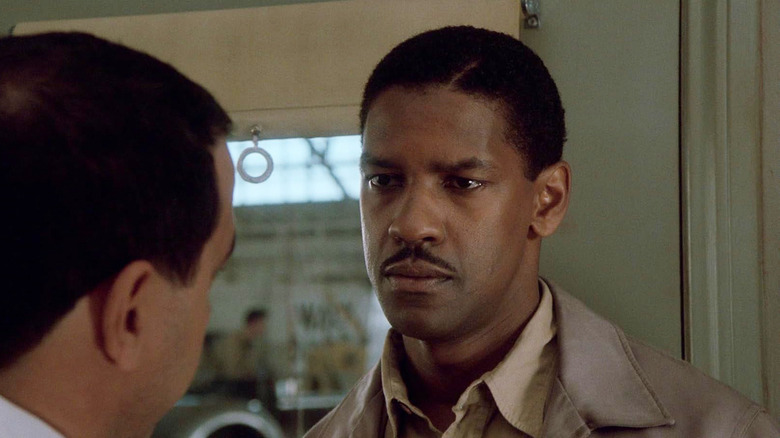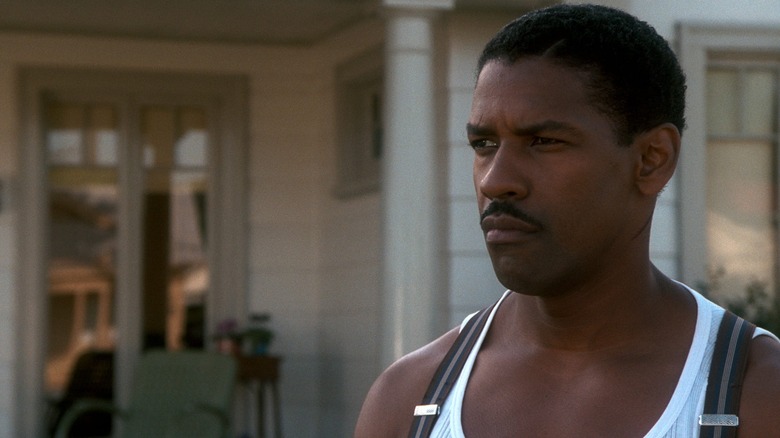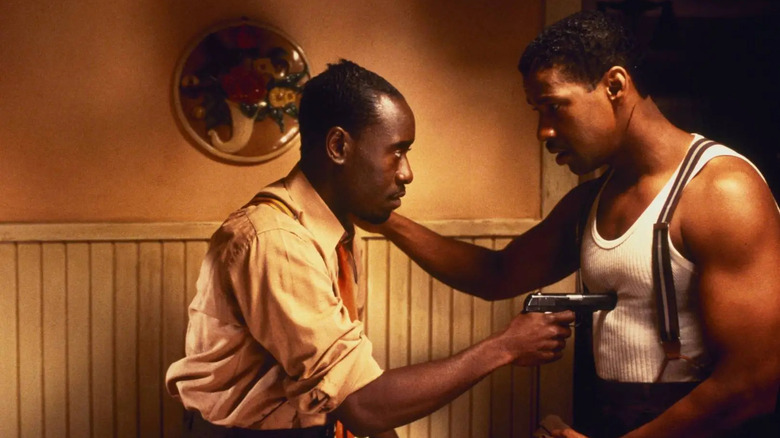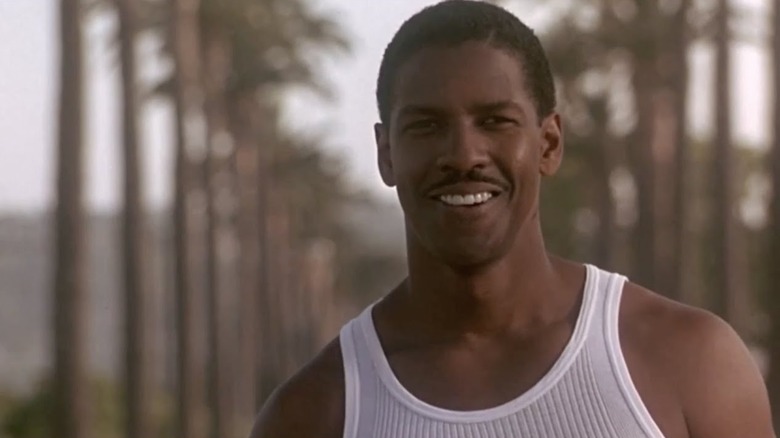One Of Denzel Washington's Best Movies Could've (And Should've) Spawned A Franchise
We may receive a commission on purchases made from links.
Carl Franklin's "Devil in a Blue Dress" was exactly two years ahead of its time, almost to the day. The director's adaptation of the first installment in Walter Mosley's Easy Rawlins series of noir novels would've been perfectly positioned in late 1997 to capitalize on the slow rolling box office success of Curtis Hanson's "L.A. Confidential." Both films were September releases building on buzzy debuts at the late summer Toronto International Film Festival, but "L.A. Confidential" proved zeitgeisty in ways that eluded "Devil in a Blue Dress." It kicked off a noir renaissance that saw national and local film critics writing up lists of must-see black-and-white crime flicks from the 1940s and '50s for their readers. Suddenly, mainstream moviegoers were up on terminology like "femme fatale," and eager to watch Humphrey Bogart movies that weren't "Casablanca."
Why did the well-reviewed "Devil in a Blue Dress" fail to whip up such excitement?
There are numerous reasons why the handsomely mounted period noir, with its A- Cinemascore, grossed a disappointing $16 million at the domestic U.S. box office in 1995, and we'll get to those in a moment. What matters most, though, is that Columbia Pictures immediately kiboshed plans to franchise the Rawlins series for star Denzel Washington. These rich, thrillingly provocative novels that piercingly conveyed what it was like to be a Black man butting heads with the white power establishment in a major (and majorly racist) American metropolis, not to mention read like feature films on the page, were going to go unexploited in a medium that cried out for their unique point of view.
The loss was all the more stinging because Washington should've been a more than magnetic enough star to pack the nation's theaters. Why did "Devil in a Blue Dress" fall short commercially where "L.A. Confidential" thrived two years later?
The Easy and Mouse show would've been a multi-film delight
Published in 1990, Mosley's "Devil in a Blue Dress" plunged readers into a vibrant post-WWII Los Angeles wherein Army veteran Ezekiel "Easy" Rawlins (sometimes just "Ease" if you're intimates) has just been fired from his job at Champion Aircraft. The still young man is plotting out his next move over bourbon at Joppy's Bar when a white man strolls into the typically all-Black establishment to make Easy a classic noir offer: find a white woman named Daphne Monet. Who's looking for her and why isn't for Easy to know. He just has to find out which bar she's calling her home away from home, and a solid payday (on top of the advance he's already pocketed) will be his.
The racial distinctions are important here because this is the late '40s, when L.A. was attracting minorities in growing numbers, creating an uneasy, segregated peace in a town viewed by outsiders as a moviemaking dream factory. When the white cops notice Easy snooping around, they bring him in for questioning. When two rival mayoral candidates become involved, Easy is suddenly up to his Jake Gittes in political intrigue. There's also a very "Chinatown"-esque family component to the mystery as well.
Mosley's tight prose and ear for dialogue make for pleasurable reading, the kind you can't put down not because you're in a rush to finish it, but because you want to stay in that gritty-glamorous world forever. A smart, sexy protagonist and jazzy atmosphere is what Mosley's selling, and, remarkably, it's what Franklin captures in his film with seemingly little effort.
Of course, Franklin has a supernova of natural charisma in Washington, and, fortunately, the then 40-year-old star was still youthful enough to portray the 20-something Rawlins. He strikes a crackling rapport with every single one of his castmates, but is at his best when bantering with Don Cheadle, who launched his career into the stratosphere (at least among casting agents) as Easy's old Houston associate Mouse.
It all depends on how Franklin and producers Gary Goetzman and Jesse Beaton would've managed Mosley's series, but it's hard to imagine them not prioritizing the novels where Mouse causes a vicious ruckus. The character is there to both save Easy from trouble and cause a good deal more of it. Mouse is lightning quick with a pistol, blade, rope or, sorry Joppy, his bare hands; in one of the later books, after he finishes a five-year bid for manslaughter, he starts killing off everyone he suspects of having given him up to the cops. Mouse is the live-wire element of the best Easy books, and Cheadle had a ball playing him (he was still up to revisit the character when I interviewed him in 2004).
There's so much here for a great filmmaker like Franklin to explore, so why didn't more people show up at the multiplexes? Possibly because they didn't know it was there in the first place.
How Denzel's Chinatown came up short
Black-themed and -directed films were proliferating at the nation's theaters in the mid-1990s, but the hits tended to be gangster flicks set in inner cities (usually L.A. or New York City). Given the popularity of gangsta rap (and hip-hop in general), this allowed marketing departments to sell the movies via soundtracks stuffed with new songs from the likes of Snoop Dogg, Dr. Dre, Naughty by Nature, and other platinum-selling artists.
Columbia did assemble a killer soundtrack for "Devil in a Blue Dress," but the hottest tracks were from the likes of Duke Ellington, Memphis Slim, and Wynonie Harris. This meant there would be no music video released a month or two ahead of release for heavy rotation on MTV, nor would there be a trailer pulsating with the latest from Toni Braxton (Allen and Albert Hughes' 1970s-set "Dead Presidents" struggled commercially in the fall of '95 for the same reason). This left Columbia with two options: sell the atmosphere and Washington or go with a cookie-cutter crime-thriller trailer that hits the same tired beats as ho-hum programmers like "Just Cause" and "The Pelican Brief." Unsurprisingly, it went with the latter.
Columbia Pictures gave "Devil in a Blue Dress" a wide-ish 1,432-screen release on September 29, 1995, but the buzz generated by its Toronto premiere meant nothing to regular moviegoers. TV ads were sparse in the run-up to opening day, and the studio wasn't selling Washington, who'd co-starred in one of the biggest hits of the just-concluded summer movie season ("Crimson Tide"). They decided the writing was on the wall, that there would be no more Easy Rawlins films, and quietly moved on.
In Columbia's defense, it was a tad caught off-guard by the surprise success of David Fincher's "Se7en," which was going great guns in its second weekend when "Devil in a Blue Dress" hit the marketplace. Without that direct competition for roughly the same demographic, the film likely would've outgrossed "Halloween: The Curse of Michael Myers" and finished number one for the weekend. Instead, it finished third, and was in second-run theaters three weeks later.
A prayer for a late-breaking return to the role for Washington
There have been efforts to revive the Easy Rawlins franchise over the last 20 years. Jeffrey Wright nearly starred in an HBO adaptation of "Little Green," while Mosley and "The Losers" director Sylvain White are currently developing a television series for Amblin Television. The material is simply too good to keep ignoring but for fans of the books, the notion that we could've had more movies with Denzel's Easy romancing women while desperately trying to keep Mouse from killing anyone who looks at him funny will linger over whatever comes next.
This is especially frustrating because Columbia Pictures is renowned for its film noir history. The studio that gave us masterpieces like "Gilda," "In a Lonely Place," "The Big Heat," "The Lady from Shanghai," and "Nightfall" should've made the success of "Devil in a Blue Dress" a point of pride. It was a throwback that belonged in the firmament of the studio's finest noir efforts.
Alas, there's no going back — or is that door still slightly ajar? It's a long shot, but Sony's Tom Rothman (now in charge of Columbia Pictures) could play the cinephile card and lure the trio of Washington, Cheadle, and Franklin back into the fold for a late-in-the-day Rawlins yarn (Mosley has some of those). Those that know would love to see it. Those that don't could be sold on the prospect now that Washington is a $20-million-per-picture superstar who opens "The Equalizer" sequels with practically zero effort. If Washington says yes, who in their right mind would say no?



